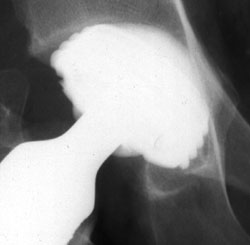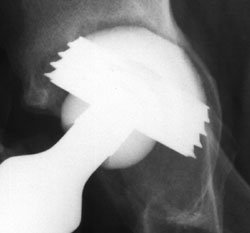Wear debris an effect, not cause of failure in ceramic-on-ceramic hips
Practically all ceramic hip failures in study were due to secondary implant instability.

VIENNA — Wear debris and periprosthetic bone resorption appear to be effects rather than causes of failure in most ceramic-on-ceramic hip bearings, according to a research team from Italy.
These results differ from those typically seen in revised metal-on-polyethylene bearings, in which foreign body cell reaction is the primary pathogenetic mechanism of failure, Nicola Baldini, MD, said in his presentation at the 10th EFORT Congress, here.
The team from the Rizzoli Orthopaedic Institute in Bologna, Italy, analyzed clinical, radiographic, microbiological and laboratory data on 30 consecutive patients with failed alumina-on-alumina total hip arthroplasties (THAs) to see if foreign body reaction to wear debris played a role in periprosthetic bone resorption. As part of the examination, the researchers studied the retrieved implants and analyzed the histology of the periprosthetic tissues.
Aside from 5 patients who required revision surgery due to late infection, all alumina-on-alumina cases failed due to secondary implant instability — including 19 cases involving screwed sockets — or due to implant malpositioning (5 cases). One patient had a chronic dislocation.
|
|
Some macrophages
In some cases with severe wear, debris was evident in clusters of perivascular macrophages, particularly in the absence of foreign body multinucleated cells, the investigators wrote in their abstract.
Baldini said he and his colleagues were not surprised that mechanical problems played a much more prominent role in the failure of ceramic-on-ceramic THAs than wear debris or periprosthetic bone resorption.
“The amount of periprosthetic osteolysis and the mode of failure, including the temporal progression of bone resorption, was quite different in ceramic-on-ceramic compared to metal-on-metal implants,” he told Orthopaedics Today Europe. “Furthermore, the vast majority of retrieved ceramic-on-ceramic implants had inadequate implant models or poor fixation.”
|
|
|
|
Mode of failure of a treaded-in acetabular component after 8 years. Images: Baldini N |
|
Minimal biologic reaction
He said poor implant design or incorrect surgical technique can cause implant instability, which may result in wear debris. However, the wear debris in ceramic implants produced little to no biological reaction in patients in the study.
“We and some others have shown that ceramic debris does not elicit a strong inflammatory reaction, both in vitro or in vivo,” he said during his presentation.
Although Baldini and his colleagues at Rizzoli have used ceramic-on-ceramic hips since the 1970s, “I think that the reliability of this solution is further supported by this study,” he added.
Baldini also said the failure rates between metal-on-polyethylene and ceramic-on-ceramic hips are comparable. Data collected in a prospective analysis from the regional registry at Rizzoli showed that the failure rate for ceramic-on-ceramic hip implants at 8 years is 1.9%, compared to 2.3% for metal-on-metal implants and 2.4% for metal-on-polyethylene.
For more information:
- Nicola Baldini, MD, can be reached at the Rizzoli Orthopaedic Institute, via di Barbiano 1/10, 40136 Bologna, Italy; e-mail: nicola.baldini@ior.it.
Reference:
- Baldini N, Savarino L, Ciapetti G, Giunti A. Wear and tissue reaction in retrieved ceramic-on-ceramic THA. Paper F68. Presented at the 10th EFORT Congress. June 3-6, 2009. Vienna.



